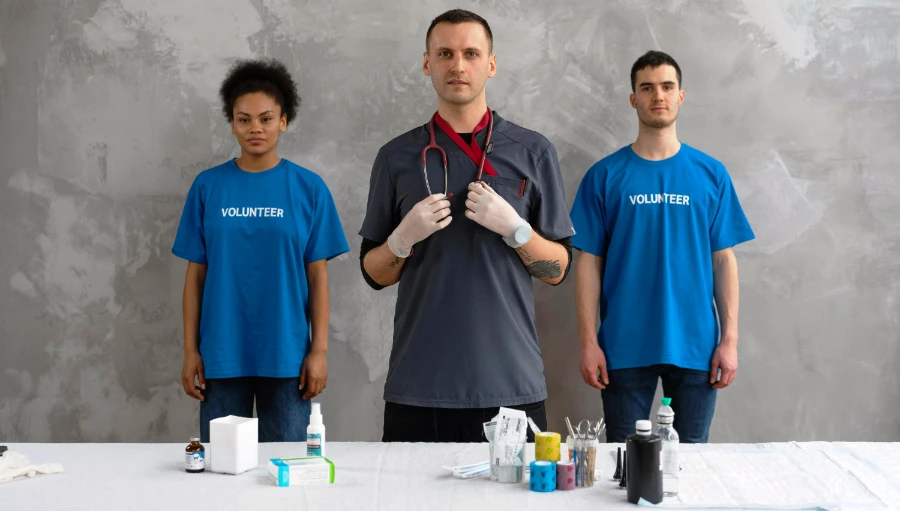The Vital Role of EMS in Community Health
September hosts many health awareness events. These events address vital health issues like aging, obesity, and substance recovery. Emergency Medical Services (EMS) play a critical role during these events. Their involvement extends beyond emergency care. EMS actively contributes to community health education, helping prevent health crises.
EMS’s efforts in health education are invaluable. They promote wellness and safety across all age groups. Their work during September’s health observances underscores their commitment to public health. Let’s explore how EMS enhances community health through education and awareness.
September Health Awareness Events: A Brief Overview
Healthy Aging Month
Healthy Aging Month emphasizes maintaining health as people age. This observance encourages older adults to stay active and engaged. EMS plays a key role in supporting healthy aging. They provide vital information on injury prevention and managing chronic conditions.
EMS also helps older community members stay safe at home. They offer tips on fall prevention and emergency preparedness. These efforts ensure that older adults can enjoy a better quality of life.
National Childhood Obesity Awareness Month
Childhood obesity poses serious health risks. September focuses on raising awareness about preventing obesity in children. EMS engages with families to educate them on healthy lifestyle choices. They teach parents and children about nutrition and physical activity.
EMS also conducts health screenings in schools and communities. These screenings help identify early signs of obesity. Through education, EMS empowers families to make healthier choices.
Substance Use Recovery and Sickle Cell Awareness
Substance use and sickle cell disease are major health concerns. September includes observances that address these issues. EMS supports these efforts by providing education and resources. They participate in community events to raise awareness.
EMS offers information on managing chronic conditions like sickle cell disease. They also connect individuals with recovery resources. Their involvement helps communities address these critical health challenges.
EMS as Educators: Building Health Literacy and Awareness
Public Safety Demonstrations
EMS hosts public safety demonstrations throughout September. These events focus on preventing injuries and emergencies. EMS personnel teach valuable skills like CPR and first aid. These demonstrations often include interactive activities.
EMS also covers topics like fire safety and accident prevention. These efforts equip community members with essential knowledge. By educating the public, EMS reduces the risk of emergencies.
Health Screenings and Preventive Care
EMS plays a proactive role in preventive care. During September, they offer health screenings at various events. These screenings include blood pressure checks and glucose testing. EMS uses these opportunities to educate the public about chronic diseases.
Preventive care helps identify health issues before they become serious. EMS’s educational efforts encourage people to seek medical care early. This approach improves overall community health.
School and Workplace Engagement
EMS actively engages with schools and workplaces. They offer tailored health education programs during September. In schools, EMS teaches students about basic first aid and safety. They also educate staff on emergency preparedness.
In workplaces, EMS conducts health and safety workshops. These sessions cover topics like injury prevention and CPR. EMS’s involvement in education promotes a culture of health and safety.
Addressing Social Determinants of Health (SDoH) through EMS
Understanding SDoH and EMS’s Role
Social determinants of health (SDoH) influence community well-being. Factors like housing and access to healthcare affect health outcomes. EMS addresses SDoH by providing education and resources. They connect community members with services that meet their needs.
EMS plays a key role in identifying health disparities. They work with other organizations to address these issues. Their efforts help improve the overall health of the community.
Data-Sharing and Community Partnerships
Effective community health interventions require data-sharing. EMS partners with other healthcare providers to share important information. This collaboration ensures that community members receive comprehensive care.
EMS also works with social service organizations. They help connect individuals with non-medical services. By addressing SDoH, EMS contributes to healthier, more resilient communities.
EMS Innovations in Community Health Education
Community Paramedicine and Preventive Care
Community paramedicine extends EMS services beyond emergency response. This innovative approach focuses on preventive care. EMS providers visit high-risk patients in their homes. They conduct health screenings and provide medical advice.
These efforts reduce the need for emergency care. EMS’s role in preventive care improves patient outcomes. Community paramedicine represents a shift towards proactive healthcare.
Leveraging Technology for Better Outreach
Technology enhances EMS’s ability to educate the public. EMS uses digital platforms to reach a wider audience. They offer virtual workshops and online resources during health observances.
These tools make health education more accessible. EMS also uses social media to share important health information. Technology allows EMS to engage with the community more effectively.
Challenges and Opportunities in EMS Community Outreach
Overcoming Barriers to Effective Engagement
EMS faces challenges in reaching diverse populations. Language barriers and varying health literacy levels can hinder outreach. However, EMS employs strategies to overcome these obstacles. They offer materials in multiple languages and use simple language in their communications.
EMS also works closely with community leaders. This collaboration helps them reach underserved populations. By addressing these challenges, EMS ensures that everyone has access to vital health information.
Opportunities for Enhancing Community Impact
Emerging trends offer new opportunities for EMS. Public-private partnerships can support community health initiatives. EMS can also leverage grant funding to expand their programs.
These opportunities allow EMS to enhance their impact. By exploring new avenues, EMS can reach more people and improve community health.
Reflecting on EMS Contributions: Building Healthier Communities
EMS plays a crucial role in community health. Their efforts during September’s health observances highlight their commitment. By educating the public, EMS helps prevent health crises and promotes wellness. Their contributions extend beyond emergency care, making them vital to community well-being.
As communities continue to face health challenges, EMS’s role will only grow. Their work in education and prevention will lead to healthier, more resilient communities. By supporting EMS efforts, communities can ensure better health outcomes for all.
Frequently Asked Questions
EMS plays a vital role in community health, particularly during health awareness events in September. While the article covers many aspects of EMS’s contributions, some questions remain about their broader impact and involvement. Here, we address additional questions that readers might have about EMS’s role in community health and education. These answers provide further insights into how EMS supports community wellness.
How does EMS contribute to mental health awareness in the community?
EMS providers often collaborate with mental health professionals to offer support during crises. They participate in mental health awareness campaigns by providing resources and information to the public. EMS also helps connect individuals in crisis with appropriate mental health services.
Can EMS help in disaster preparedness beyond emergency response?
Yes, EMS plays a crucial role in disaster preparedness by educating the community on emergency plans and safety measures. They conduct drills and workshops to help individuals and families prepare for natural disasters. This proactive approach ensures that communities are better equipped to handle emergencies.
What role does EMS play in addressing chronic disease management?
EMS engages in chronic disease management by offering regular check-ups and health monitoring for at-risk individuals. They provide education on managing conditions like diabetes or heart disease, helping to prevent complications. This ongoing support reduces the need for emergency care.
How do EMS teams work with other healthcare providers in the community?
EMS collaborates with hospitals, clinics, and social services to create a seamless healthcare network. They share vital information and coordinate care to ensure patients receive comprehensive services. This partnership enhances the overall effectiveness of community health initiatives.
Recommended References on EMS Contributions to Community Health
Here are five reputable sources that provide valuable insights into the role of EMS in community health, particularly in Florida. These references offer additional context and information related to the article’s topic.
Florida Department of Health – EMS Services
This official page provides comprehensive information on EMS services in Florida, including their role in public health and emergency preparedness.
Broward Health – Emergency Medical Services
Broward Health’s EMS page details their contributions to community health through emergency response and public education initiatives.
The EMS Ricky website offers various resources and insights on how EMS professionals contribute to community health and emergency response.
Leon County Government – Emergency Health Services
Leon County’s page on emergency health services highlights how local EMS teams contribute to public safety and health awareness.
City of Tampa – EMS & Fire Rescue
The City of Tampa provides an overview of their EMS and fire rescue services, emphasizing their role in community health and safety education.

Jeromy VanderMeulen is a seasoned fire service leader with over two decades of experience in emergency response, training, and public safety management. He currently serves as Battalion Chief at the Lehigh Acres Fire Control & Rescue District and is CEO of the Ricky Rescue Training Academy, a premier provider of online and blended EMT and firefighter certification programs in Florida.
Jeromy holds multiple degrees from Edison State College and the Community College of the Air Force, and is pursuing his MBA at Barry University. He maintains top-tier certifications, including Fire Officer IV, Fire Instructor III, and Fire Inspector II, and has served as a subject matter expert for a court case. He is a member or the Florida Fire Chiefs Association.
Jeromy also contributes to state-level fire safety regulation and serves on several hiring and promotional boards.

